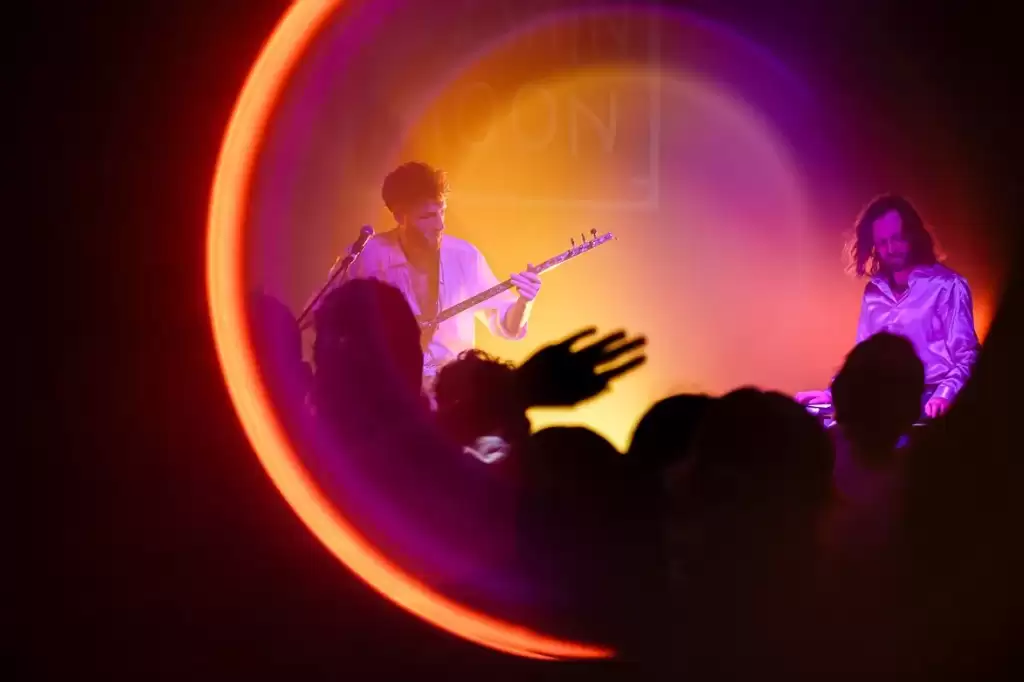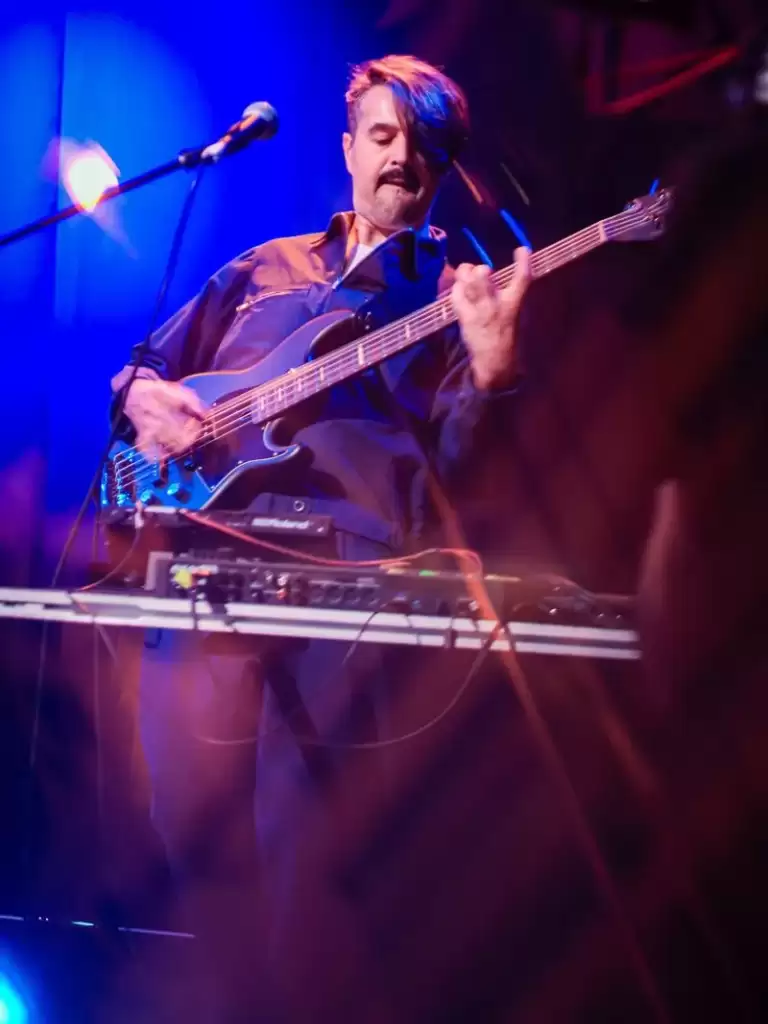The ‘Nowruz Party’ festival, which featured prominent artists from various music genres of Iran, took place on March 16th at Rich Mix in London. The presence of renowned contemporary Iranian female artists in this festival was one of the notable aspects that added to the significance of the program. In this festival, performances were witnessed by Emma, an Iranian singer and songwriter based in Vienna, with her EDM duo, EXEA, and Golsa, a singer and songwriter based in Tehran, accompanied by Sardar Sarmast, a member of the rock band 127, and Reza Farhadi, a producer and bass player. Additionally, Saeed Aman, an Iranian-Italian electronic musician and co-founder of the music band BowLand, and Azim Fathi, an Iranian DJ, performed music sets. To mark the occasion of this festival, we spoke with Hesam Garshasbi, the founder of Vaak Records and the organizer of this festival, and Saeed Aman about the current status of alternative music in Iran.

Photo: Ali Zamani
Table of Contents
ToggleFor years, we’ve been accustomed to the focal point of all musical events during the Persian New Year revolving around the presence of Iranian pop singers in satellite TV programs and overseas Nowruz concerts. Consequently, it seems that alternative artists and music groups, despite all the existing constraints, have a much better situation inside Iran compared to abroad. Therefore, these music groups are not as appealing to concert organizers outside of Iran. Do you agree with such a statement?
Hesam Garshasbi: Yes, that’s entirely accurate. Every year on the eve of Nowruz, more than anything else, we witness the organization of programs defined by mainstream or pop culture. We’ve been and continue to be witnesses to these events, not necessarily their audience. It can be said that alongside this mainstream approach, we have, from the past, alongside people like ourselves, created our own space and celebrated Nowruz within it. Now perhaps it can be said that this space is expanding. (Something that, with the nature of Nowruz as a celebration for all ethnicities and tastes, has complete coordination.) As we even recently see, some mainstream media outlets outside of Iran are paying more attention to music streams outside of the mainstream of Iranian music.
What is your main concern about providing an opportunity for the new generation of Iranian musicians in international scenes?
My main concern has always been “freedom of expression in Iranian music.” In other music scenes globally, there are specialized music publishers or concert organizers catering to non-mainstream, indie, or underground music. Their focus is usually on artistic experimentation, which can lead to new trends diverging from the mainstream, a savvy strategy in the competitive music market. These alternative trends may eventually become mainstream themselves, finding broader audiences. However, for individuals like me who have encountered restrictions and censorship from a young age, the paramount issue remains freedom of expression in music.
This challenge is particularly acute for Iranian female musicians, making it a top priority to create opportunities for them. Additionally, we’ve cultivated a distinct niche audience, and I’m continually amazed by the positive reception our concerts receive. This growing support emboldens me to take risks by featuring promising artists in our programs rather than sticking to established ones.
Our selection of musicians for the “Nowruz Party” is influenced by several factors outlined in my previous responses. We aimed to curate a celebration aligned with our musical tastes, distinct from the mainstream events often found in multicultural cities like London. Furthermore, we sought artists who lack opportunities to perform in Iran and those whom we believe possess untapped potential to thrive in the music industry. I must emphasize that I am not alone in this path and I have colleagues without whom these programs would not be possible. Especially the “ArtStage” group, which has been a strategic partner in the publication of Vaak Records in the past two years. Part of the answer to the question of why we chose these musicians for the “Nowruz Party” is in my previous answers.
Another concern is fostering interaction between Iranian musicians and those from other countries. In recent years, I’ve observed a tendency for both Iranian musicians and their international counterparts to remain within their respective bubbles. This contrasts with the cultural exchange seen among artists of other nationalities in diverse cities like London, where they actively introduce their music and art to different cultures, thereby expanding their audiences.

Photo: Hydar Dewachi
Over the past two decades, a significant number of rap artists in Iran have seriously focused on operating within the alternative framework. Can we expect concerts by these rappers outside of Iran soon?
I must say, the Persian rap scene surprises me. In terms of diversity and production spread throughout Iran, as well as the level of youth reception and audience expansion. You’re aware that within the Persian rap scene, there are various currents and groups, some of which occasionally perform live outside of Iran. One of my wishes is to organize a festival themed around Iranian rap (not just Persian rap) in Europe, especially inviting rappers from outside the center (Tehran) to perform there. I believe this movement has its own special audience and can potentially attract a significant audience in Europe.
How promising has the trajectory of the alternative music scene in Iran been in recent years?
The breadth and diversity of alternative music in Iran, especially female musicians, astound me. Every day we witness the introduction of a new face to Iranian music enthusiasts, both domestically and internationally. If over the past four decades, we have had a prominent figure in Iranian music each decade, now that prominent figure is not an individual but a group, and that group is the female musicians of Iran. The alternative movement in Iran has shed its skin as a whole; it’s no longer just about “releasing work,” it has moved beyond this stage, and the issue now is the quality of the produced works and building a loyal audience base. I am very optimistic about the future of this movement.
How promising has the trajectory of the alternative music scene in Iran been in recent years?
Hesam Garshasbi: The alternative music scene in Iran has seen remarkable growth and diversity in recent years, particularly among female musicians. There’s been a continuous influx of new talent captivating Iranian music enthusiasts both locally and globally. Unlike previous decades where prominent figures dominated, the current spotlight is on a collective: the female musicians of Iran. This movement has evolved beyond mere release of music; it’s now about the quality of the content and fostering a dedicated fan base. I am very optimistic about the future of this movement.
Saeed Aman: In the past two decades, alternative and underground music in Iran has seen significant growth and evolution, marking a stark contrast to its limited presence twenty years ago. Back then, only a handful of musicians and bands were known, and challenges in performing, producing, and distributing music were abundant. However, advancements in technology have since alleviated many of these obstacles, empowering artists to take control of their own music production, distribution, and promotion, particularly through cyberspace and social media. As a result, there has been a noticeable increase in both the quantity and quality of alternative and underground music in Iran. While legal and social conditions may not have changed significantly, the accessibility provided by technology has fostered a more vibrant and diverse music scene, with new phenomena emerging regularly. This transformation brings optimism for the future of these music genres in Iran.

Photo: Hydar Dewachi
What factors have contributed to the gradual decline or growth of Iran’s alternative music?
Saeed Aman: The music scene in Iran has experienced an overall upward trend in the past two decades, despite facing significant challenges. Legal restrictions on musicians’ activities, including the inability to hold concerts within Iran, have hindered their financial stability. Iranian musicians also lack the ability to earn income from copyright rights, unlike their counterparts in Europe and America. Moreover, social stigma surrounding being a musician in traditional areas further complicates the growth of artists. However, these limitations have also sparked motivation and creativity among musicians. While acknowledging the obstacles, there is optimism for the future of the Iranian music industry, with potential for a golden age of alternative and underground music once these limitations are addressed.
What can be expected from the audiences, artists, and media both inside and outside Iran so that with their support, more musicians to be inclined to engage in these genres?
Saeed Aman: I believe that most people active in this field are currently doing the best they can with good intentions. In my opinion, continuing on this path, in the natural course of events, will eventually be very exciting. But I think with proper planning and a large-scale collaboration between all stakeholders in the music industry, from artists and audiences to media, creating an alternative to the lack of an alternative music industry in Iran is possible. I believe that with the use of technology, we can achieve this goal, so that artists can earn income from their musical activities through a specific system, even if they live in Iran and may not be able to hold concerts or earn royalties. In my opinion, if such a system is created, the formation of a large-scale collaboration between artists, publishers, media, and music audiences will lead to the creation of an economic ecosystem. As a result, music will become a real job for many artists.

